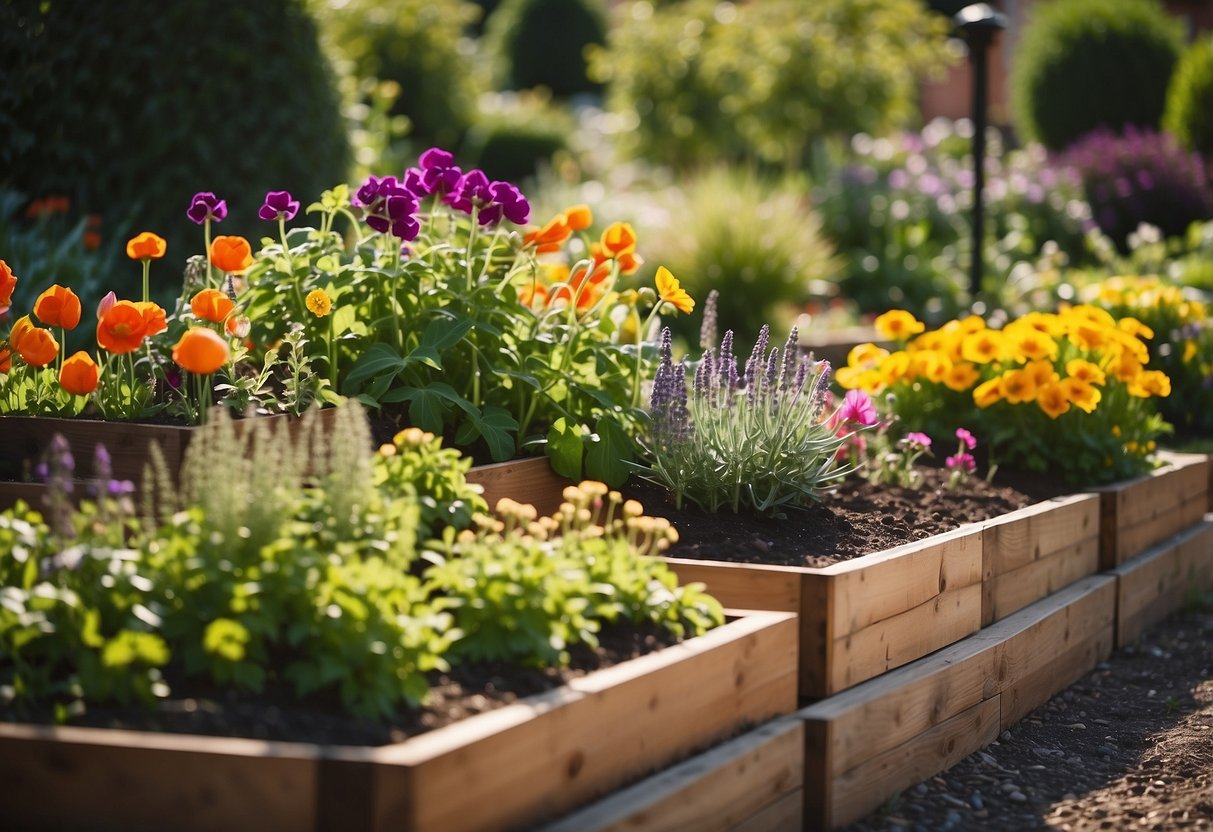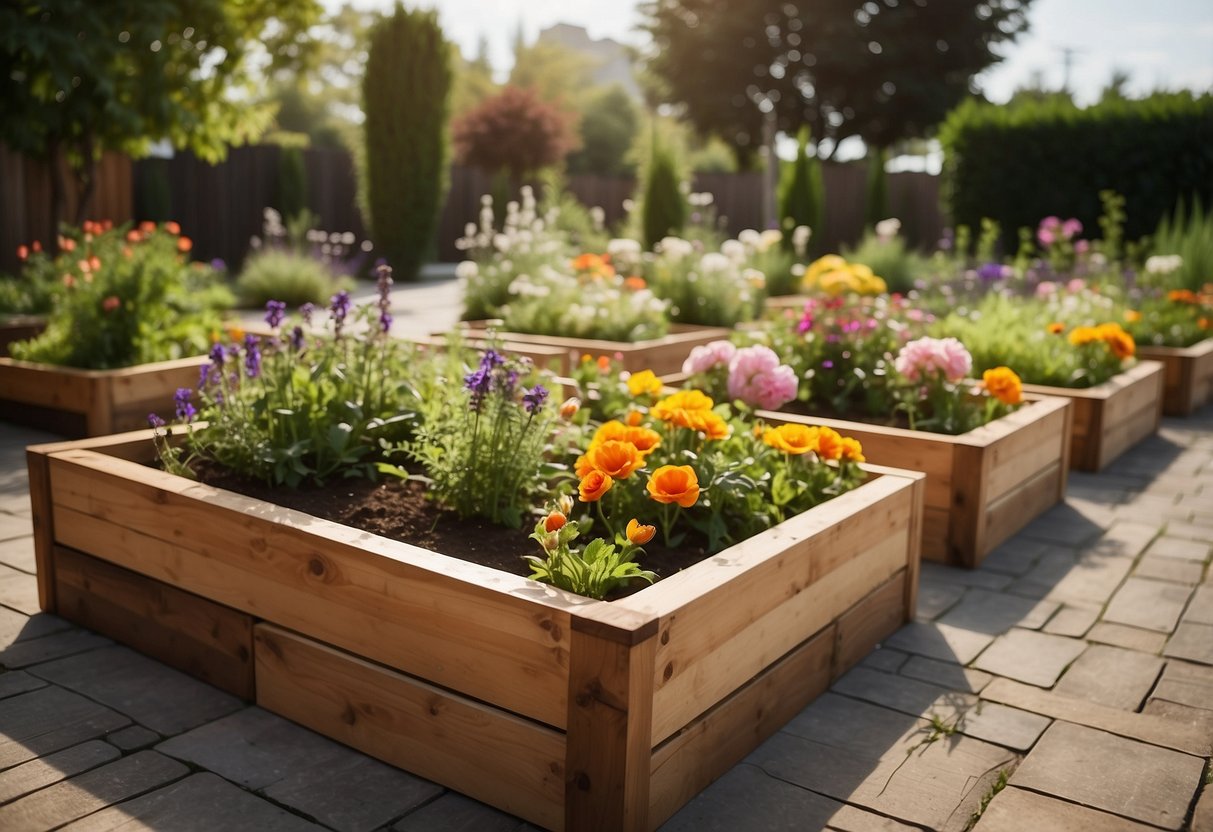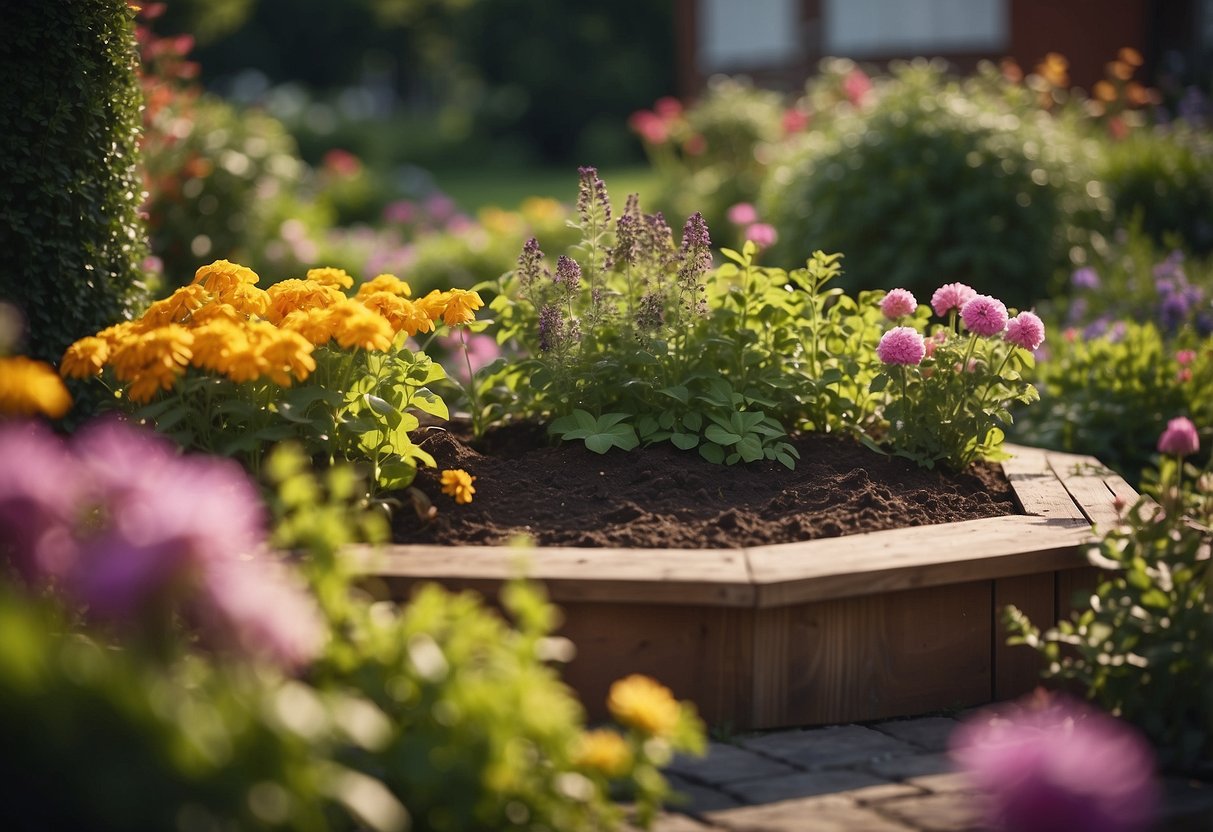Front Garden Raised Beds Ideas: Transform Your Outdoor Space
Creating a front garden with raised beds can transform the look of your home while also providing a practical space for growing plants. Whether you’re working with a small or large area, raised beds offer flexibility in design and can adapt to various styles, from modern to rustic.

Why choose raised beds for your front garden? Raised beds improve soil drainage, make gardening tasks easier, and allow you to customize the soil for your plants. By using raised beds, you can create an attractive and efficient garden space that enhances your home’s curb appeal.
1) Herb Spiral

A herb spiral is a wonderful addition to your front garden raised beds. It’s a raised garden bed shaped like a spiral, taller in the middle, and gradually lowering as it moves outward.
Herb spirals can be made from materials like stone or wood, providing diverse growing conditions in the same bed.
These structures are popular in permaculture design and can often be built using materials found on site. Learn more about creating a herb spiral for a beautiful, productive, and practical feature in your garden.
2) Square Foot Grid

Using a square foot grid is a great way to organize your front garden raised beds. You divide the bed into smaller sections, each one-foot square.
This method makes it easy to keep track of what you’ve planted and ensures each plant has enough space to grow. You can use string and nails to create the grid.
Planting in a square foot grid allows you to grow a variety of vegetables like cilantro, basil, and garlic. This garden plan also works well for growing tomatoes and peppers, making your front garden lush and productive.
3) Wooden Raised Beds

Wooden raised beds are a popular choice for front gardens. They are easy to build and customize. You can paint or stain them to match your home’s exterior.
Cedar and redwood are great options because they resist rot. These materials make your garden bed last longer.
You can find more ideas and inspiration on Houzz.
4) Tiered Planter Boxes

Tiered planter boxes are perfect for your front garden. They add height and dimension, making your space look more interesting. You can plant taller plants in the back tier and shorter ones in the front.
A tiered raised planter by Hydrangea Treehouse lets you grow more in less space. This is especially helpful if your garden is small.
Building a tiered raised garden bed can be a fun DIY project. All you need are some cedar fences and 2x4s. Check out Anika’s DIY Life for a simple guide.
5) Keyhole Garden Bed

A keyhole garden bed is a unique and efficient option for your front garden. This style is a large, raised bed often in a circular shape with a composting basket in the center.
You can easily water your plants by pouring water into the center composting basket. As the water seeps through, it carries nutrients to your plants. Build the walls from materials like bricks or rocks to create a sturdy structure. Keyhole gardens are functional and add a distinctive touch to your outdoor space. Learn more about building one on Rural Sprout and PreparednessMama.
6) Concrete Block Beds

Concrete blocks are a great choice for raised garden beds. They’re sturdy and durable. You can find them at most home improvement stores.
These blocks are easy to stack. You can build low or tall beds, depending on your needs. It’s also simple to add more blocks if you want to expand later.
Another advantage is that they’re budget-friendly. You don’t need fancy tools to put a concrete block bed together. Just some blocks and a little time!
For more ideas and detailed steps on building a raised garden bed using blocks, check out this guide.
7) Recycled Materials Beds

Recycling materials for your raised beds is a sustainable choice. You can use wood scraps, old pallets, or even broken concrete blocks. These materials are often free and give a charming, rustic look to your garden.
Old metal or plastic containers can also make great raised beds. Just be sure to drill drainage holes if needed and choose safe materials for food plants.
8) Metal Trough Beds

Metal trough beds are a stylish and durable option for your front garden. They add a modern touch while being practical for growing plants.
You can use galvanized metal troughs or even old livestock water troughs. They offer excellent drainage and are easy to maintain.
Plus, the metal keeps the soil warm, which helps your plants grow better. Try arranging a few different sizes for a creative look. For more ideas, check out this guide.
9) Vertical Planter Walls

Vertical planter walls are a great idea for making the most out of limited space. They are easy to set up and can transform your front garden into a green oasis.
You can use wooden slats or metal frames to mount the planters. Consider using colorful pots to add a vibrant touch.
This approach also helps in managing different types of plants in one spot, giving your garden a more organized look. Check out these DIY ideas for vertical gardening to get started!
10) Integrated Seating Beds

Integrated seating beds are a great way to add functionality to your garden. These raised garden beds come with built-in benches, allowing you to sit and enjoy your plants up close.
With this setup, you can relax and take care of your garden without needing extra seats. It’s a perfect solution for small spaces.
You can create these using various materials like wood, stone, or metal. They add both beauty and practicality to any front yard garden. For more ideas, check out these creative designs.
Benefits of Front Garden Raised Beds

Front garden raised beds can transform your yard into a functional and visually appealing space. They offer better soil quality, improved drainage, and easier accessibility, making gardening more enjoyable and productive.
Enhanced Soil Quality
One of the biggest advantages of front garden raised beds is the ability to control soil quality. You can choose the best soil mix for your plants, improving growth and yield. Amending the soil with compost, organic matter, and nutrients becomes easier and more effective.
Good soil quality means fewer weeds, as you can start with weed-free soil. This saves you time and effort. Plus, you can avoid soil compaction, which is common in traditional garden beds. Better soil structure leads to healthier plants, making your garden thrive.
Improved Drainage
Raised garden beds offer better drainage compared to traditional in-ground beds. By elevating your plants, you can prevent waterlogging and root rot. This is particularly helpful in areas prone to heavy rainfall or poor drainage.
Good drainage ensures that water reaches the plant roots without pooling. This promotes healthy root growth and reduces the risk of fungal diseases. You can also add materials like gravel or sand to the bottom of the beds to enhance this benefit.
Easier Accessibility
Front garden raised beds are more accessible for everyone. By raising the soil level, you reduce the need to bend or kneel, making gardening easier on your back and knees. This is especially beneficial for older adults or those with mobility issues.
You can design raised beds to be the perfect height for comfortable gardening. Adding seating around the beds can provide a place to rest while tending to your plants. Accessibility means more enjoyable gardening experiences and increased productivity in your garden.
Design Tips for Front Garden Raised Beds

To make your front garden stand out, you need to choose the right materials, set the optimal bed height, and ensure the beds match your landscape’s aesthetics.
Choosing the Right Materials
Selecting the right materials helps ensure longevity and compliments the overall garden design. Wood is a popular choice. Cedar and redwood resist rot better than pine. If you prefer a more industrial look, consider galvanized metal. It’s durable and adds a modern touch.
For a more natural feel, stone or brick can be excellent options. These materials often require less maintenance and can blend well with traditional home styles. Just make sure any materials you choose are safe for growing food if you plan to plant vegetables.
Optimal Bed Height
Getting the height right is crucial for both plant health and ease of maintenance. A good height for raised beds is between 12 to 24 inches. This allows deep root growth and reduces the need to bend over too much.
For those with mobility issues, consider beds that are around 30 inches high. This height is ideal for wheelchair access and easier on your back. Remember, taller beds may need more soil, which can be heavy and expensive.
Aesthetic Considerations
Aesthetics play a big role in making your garden inviting. Matching the raised beds to your home’s style can improve curb appeal. If you have a modern home, clean lines and simple shapes work well. For a cottage-style home, rustic wooden beds with an aged look add charm.
Consider the color palette of your plants and beds. Coordinating your flowers and foliage with the color of your home and your raised beds can create a harmonious look. Adding decorative elements like trellises or garden art can also enhance the visual appeal.
By focusing on these key areas, you can create beautiful and functional raised beds in your front garden.
Maintenance and Care

Maintaining your front garden raised beds involves seasonal routines, pest protection, and ensuring proper watering. These tasks help keep your garden healthy and productive.
Seasonal Maintenance Routines
Throughout the year, your garden will require different care based on the season. In spring, add compost to enrich the soil and remove any weeds that have started to grow. Plant new seeds or seedlings, and stake taller plants for support.
During summer, mulch helps retain moisture and keeps the soil temperature stable. Prune plants to encourage growth and remove spent flowers to promote more blooms. Regularly check for any signs of disease or pests.
In fall, clear out dead or dying plants and add fallen leaves to the compost bin. Cover your garden beds with a layer of mulch or compost to protect them during the winter. This helps maintain soil health for the next growing season.
Protecting Your Beds from Pests
Pests can quickly damage your garden if not managed. You can start by using physical barriers, such as row covers or netting, to keep insects and birds away from your plants. Planting marigolds, which can repel certain pests, around your garden bed is also beneficial.
Introducing beneficial insects like ladybugs and lacewings can help control harmful pests. Keep an eye out for signs of trouble, such as holes in leaves or chewed plant stems. If you notice any issues, address them promptly with organic pest controls such as neem oil or insecticidal soaps.
Regularly check and maintain the health of your soil to prevent disease and pest problems. Healthy, nutrient-rich soil supports stronger plants that are better able to resist pests and diseases.
Ensuring Proper Watering
Proper watering is essential for the health of your raised garden beds. Water your plants early in the morning or late in the evening to reduce evaporation and ensure the water reaches the roots. A drip irrigation system can be very effective for delivering consistent moisture to your plants.
Check the soil moisture regularly. Stick your finger about an inch into the soil; if it feels dry, it’s time to water. Be cautious not to overwater, as this can lead to root rot and other issues. Typically, most plants need about 1 inch of water per week, but this can vary based on plant needs, weather conditions, and soil type.
Mulching helps retain moisture and protects the soil from temperature fluctuations. Use organic mulch like straw or wood chips to cover the soil around your plants. This keeps the soil moist and reduces the need for frequent watering.







